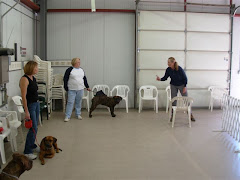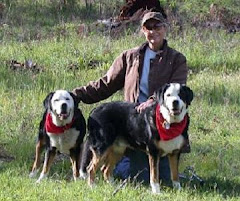
I finally bought an electronic (aka "shock") collar for my terrier, and it's working miracles.
Now, I have this young pit bull who's extremely well behaved and sensible...but she's still a terrier! That means she'd love to chase every moving critter that looks like a potential playmate. In Montana, that includes deer, elk, wild turkeys, and maybe even a bear. If any of those animals are young'uns, their moms are likely to attack her and seriously hurt her. I don't want her chasing blindly into fences, traffic or trains either...or getting lost, shot or stolen in the process.
Mind you, 90 percent of the time she's under strict voice command or on a leash. And when our back yard is fenced in the spring, that's where she will spend the majority of her outdoor time. But 10% of the time she is still vulnerable to those temptations that wander across our property on a daily basis. If she saw a whitetail across the driveway, she'd be gone, regardless of what we'd scream at her. She is, after all, a dog.
So I went on-line to Cabelas and found volumes of information, options, and models of e-collars. I picked a simple one that offered a vibration, a "nick" (momentary shock), and a sustained shock. It also had a wide range of intensity settings, and was rechargeable. The manufacturer is "Dogtra," which I later learned is one of the favorites among gundog owners.
There are two parts to this collar: the part she wears, and the small transmitter I hold on a lanyard around my neck. This system requires me to observe her and "zap" her by pushing a button on the transmitter the instant I see the wrong behavior. You can imagine how important timing is. If your timing is off, i.e., if you push the button at the WRONG moment, you can mess up your dog by confusing, scaring and sometimes even traumatizing him.
After charging the unit (the collar and transmitter) for 14 continuous hours, as per the directions, I put the collar on Lizzie. She is extremely tolerant of anything I dress her in , so she never complained when I fastened the collar fairly snugly against her neck. A snug fit is absolutely essential to make the e-collar work.
I let her wear it for a day or so before I ever tried "zapping" her. I wanted her to get used to the collar and not instantly associate an unpleasant experience with it. So I walked her on a long leash and practiced about 150 "coming when called" routines....calling her with exactly the same voice each time, reeling her in if I needed to, and ALWAYS rewarding her with praise and a piece of Flint River Ranch kibble. This served to reinforce the dozens of hours we'd already spent over the past year, working on recalls and other obedience commands in more conventional settings.
On the third day I turned on the collar and practiced some safe off-lead recalls at a very short distance without "zapping" her. My intent was to set us both up for success, and to practice several repetitions of that success before testing her with a temptation. To get her to go out and away from me, I threw a toy and sent her to it. As soon as she grabbed it, I'd call her back to me and provide an immediate treat when she reached me. Gradually I lengthened the distance of the recall until she was going out as far as I could throw the toy. Each time I called her, she came running back, happily and directly, to get her treat. No zap needed.
Next, I got out our Chuck-It tennis ball launching wand so I could pitch a ball much farther. Still she came back with it every time I called her, withou any zap...until she picked up the scent of deer poop in the grass. She slammed on the brakes and her nose went to the ground.
NOW! I hit the "nick" button, she jumped a couple inches off the ground, and came running back to me with even more intensity than she'd shown before. I praised her all the way in, acting as if I knew nothing of the "bite" she'd just received out there when she'd hesitated to come to me. The message to Lizzie: respond immediately to Mom's command to "come." If you wait, something unsettling might happen. Mom represents safety and security. Run quickly to her!
Our recalls had improved greatly. But I still had the problem of Lizzie wanting to chase deer and other wildlife. Lizzie needed to learn that deer and turkeys were "electrified" and that it was best to leave them alone. Since I couldn't explain that to her, I relied on the e-collar to deliver the message in her own language.
So we took some off-leash walks down our long, forested driveway. I let her range out in front of me and off to the sides, while I kept my eyes peeled for deer. A couple times I saw her freeze, point, and then take off running. If I didn't see what she was chasing, I would call her, wait a split second to listen for collar tags moving back in my direction, and then "nick" her if I heard nothing.
The success rate in getting her to U-turn and run back to me was 100%. And it didn't take a shock. In fact, over the next three or four days, I might have pushed the "nick" button all of three times. The rest of the times, she came FLYING to me as soon as I called, "Lizzie, come!"
Now I had confidence to take her on an off-trail hike on our 40 acres of mixed timber and meadows. I let her range out in from of me, but always kept her in sight. If she disappeared in the brush, I'd immediately call her to me and she'd reliably come running.
Prior to using the collar, I'd verbally nag her a lot to keep her attention on me. Lots of "Lizzie, let's go. This way! Leave it! Good girl! Come on," etc. Now I found myself walking silently, with my finger on the button as I waited for her to make a mistake on her own. It was hard to keep my mouth shut, but I knew I had to teach her to behave the right way around wildlife whether I was there to command her or not.
Suddenly I saw her take off like a rocket...but I didn't see what she was chasing. So I gave her the "Lizzie, come!" command, listened to determine if she was coming back to me, and then, when I did NOT hear her coming, I zapped her momentarily with the "sustained" button.
"Yike!" I heard, and she came high-tailing it back to me. I gave her a treat and some praise, and acted like I didn't know what had just happened.
"Yike!" I heard, and she came high-tailing it back to me. I gave her a treat and some praise, and acted like I didn't know what had just happened.
It was two days later when we encountered some wild turkeys on our hike. Lizzie charged out ahead of me and veered off the road toward the turkeys. I said nothing but zapped her when she was within 20 feet of the birds. "Eeyike!" I heard again, and she came beat-feeting back to me.
Yesterday we stepped outside and saw three whitetail deer across the driveway. Lizzie looked at them with calm but wary interest. I said nothing. And she walked right past the deer. SUCCESS!!! Lizzie had learned that wildlife was electrified. She could look, but not chase. And when Mom says, "Lizzie, come!" it's best (and more fun ) to come running to her as fast as you can!
Electronic collars are not for every dog. I'd never recommend them for a neurotic or hypersensitive dog. Nor are they to be used as shortcuts when trainers are too lazy to use conventional methods first. Probably the ideal candidate for an e-collar would be a good-natured Labrador with a fairly high tolerance for discomfort and a very forgiving attitude. For such a dog, the e-collar basically makes certain behaviors inconvenient or uncomfortable. My dog, Lizzie, is a pit bull with a Labrador personality. Like Lizzie, e-collar candidates should be sensible dogs who basically make good decisions except when extreme temptation gets in the way.
A bad candidate for an e-collar would be a border collie or Cocker Spaniel, both typically so hypersensitive that the correction from the collar could have a negative effect. I also know a Pointer with such a goofy drive to hunt that she will accept a shock and keep on going. The higher the dog's motivation, the higher her pain threshold will be. I guess it's that same adrenaline rush that makes all of us do dumb, risky things from time to time. However, a good upbringing aids us in making the right decisions regarding our behaviors, and dogs are the same. If the Pointer had been raised with strong leadership that emotionally strengthened her, even she would be able to resist the temptation to run amok in the field.
My biggest concern now with Lizzie is that she'll get wise to the collar and fall back on her old ways when she knows she's not wearing it. So I continue to have her wear it all of her waking hours. When I take the collar off at night, I simultaneously remove her other buckle collar, so she's not sure which is the real thing. I plan to keep this up for at least three weeks...following her around with my finger on the button as I carefully lead her into temptation. By spring she should be totally uninterested in chasing wildlife and will be as good as ever on her recalls.
This collar set us back about $230 and so far has been well worth it. It's held a charge very well, and recharges fully overnight. I figure it'll save me at least that much money in vet bills. Last summer I spent $160 getting Lizzie's ear stitched up after she ran headlong into a barbed wire fence. She'd been chasing a deer.
Do you need an electronic collar for your dog? Ask a trainer/behaviorist first. Call Manning Dog Training at 574-4008, and either Jane or Lisa can help you.


















2 comments:
Thanks Jan,. The story regarding the electric collar was very helpful for Bob and I.
Would this work for Steffi on a walk? She tries to go after cars when we are walking and I'm afraid we are going to get hurt.
Barbara Cooper
If a dog is vocalizing in response to an e-collar shock, the collar setting is too high. Most dogs will respond at a setting lower than one that will make them yip out loud. You need to make sure your collar setting is the right one for your dog. That's the step you missed in this otherwise good write-up. You start low and move up to higher shock levels as needed.
Post a Comment